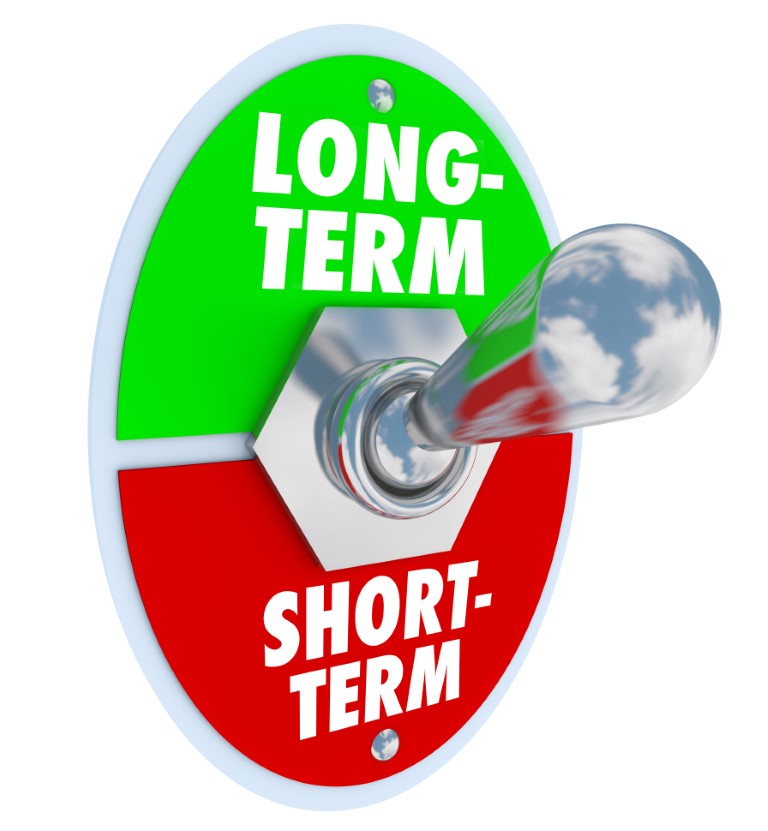There is an eternal debate about Short Term vs. Long Term. But how do you achieve a balance between both, and what can you do when you work for a corporation that lives and dies by quarterly results?
The facts remain true whether you work for a public or private company, or a for-profit or non-profit organization. No matter how you look at it, a healthy Short Term is necessary for a successful and durable Long Term, and a healthy Long Term is necessary for a series of successful Short Terms.
Let’s start with few helpful definitions: The short term is usually defined as referring to less than a year (i.e., the results of 3 or 4 quarters), while the Long term is usually defined as referring to results beyond one year (i.e., results of 3 or 4 years in the future).
Because quarterly results influence the price of shares in a public company and indicate a positive or negative performance for a private company, executives always want to have positive quarterly results. In their drive to do so, they may take actions that are detrimental to the long term. It’s like speeding to get to your destination on time but burning the car’s engine in the process. Or avoiding auto-maintenance expenses to reduce costs for the short term, but ultimately resulting in more costly repairs down the road.
This is what happens when corporations fail to manage their “productivity” and restructure by firing large numbers of people in mass downsizings or cover up for the performance of unprofitable stores or business units by closing them down in a mass reorganization or a fire sale of business units. These massive corporate restructures indicate that the company was heading in the wrong direction for some time. Regardless if the deterioration in performance was due to insider reasons, or to external market conditions, it points to a board of directors that was asleep at the wheel.
Here are five excellent tools that can help balance the short-term and long-term business performance. They can apply to both, public and private companies alike:
Up-to-date Strategic Plan: An up-to-date strategic plan (5 years) will help spell out the key strategies and tactical steps to be used so you can get from where you are to where you want to be. It is a plan that highlights what needs to be done to achieve success and sustain a good performance, short- and long-term.
A Budget covering 8 quarters: This is a key tool to monitor the monthly and quarterly business performance against a set plan. The benefit of a two-year budget helps eliminates the myopic view developed by the one-year cycle, and forces senior management to improve their forecasting.
Monthly KPI Report (Key Performance Indicators): A monthly KPI Report that tracks key drivers of business performance and easily highlights strengths and weaknesses of short-term execution allows management to respond faster to short-term opportunities and challenges. A monthly KPI is like a monthly Health Card that includes an X-ray, temperature, blood pressure, blood test, weight, etc. The benefits of a monthly KPI are many, but can be summarized in a simple and consistent “Business Performance Score Card.” This will help senior management execute with excellence.
Better Forecasting: An up-to-date and quality forecasting system of business performance is very important in order to promptly predict deviations from budget and plan. The earlier you know these differences, the sooner you can address them. The integrity, accuracy, and timely availability of the numbers that monitor business performance can also indicate that a senior-management team is in control of the business or not. It is understandable to have some deviation between the actual results and the budget (prepared few months earlier), but large deviations and gaps may indicate a management that is throwing darts in the dark.
Marketplace update: Lastly, always invest in reviewing the dynamics of your market place at least once a year. What has changed and what may change in the future? Staying on top of changes occurring in your market place and identifying positive changes vs. the negative ones allows you to better predict the future, especially with regard to customers, competitors, technology, government, and so on.
A succession of positive short-term results does not guarantee good long-term results. A successful long-term performance depends on excellent execution on both the short-term and long-term.


